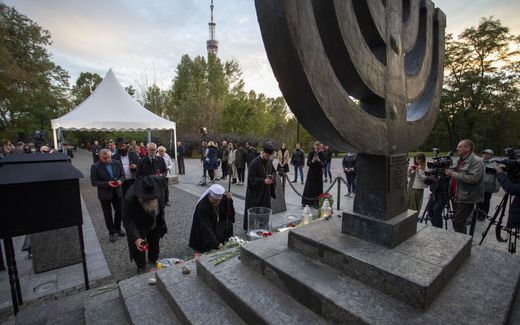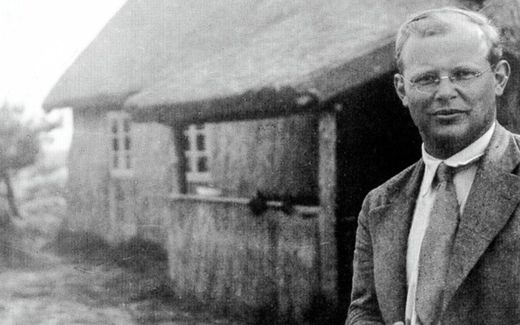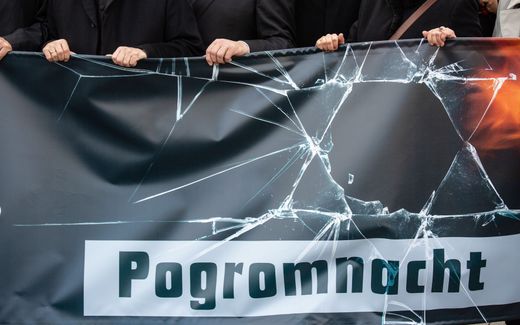Brave German teacher resists Hitler
29-11-2022
Central Europe
A.B. Goedhart, RD

View of the rail way tracks at the former Nazi concentration camp Auschwitz-Birkenau in Oswiecim, Poland. Many Jews were killed there during the Holocaust. Photo AFP, Janek Skarzynski
Central Europe
Two weeks after the Night of Broken Glass in 1938, Elisabeth Schmitz knew it for sure. With the last Jews, also Christianity would disappear from Germany. Who was this concerned German teacher?
"Because we remained silent on 1 April 1933 (start of the boycott of Jewish businesses in Germany)," Schmitz wrote, "because we remained silent at the propaganda vitrines of Der Stürmer (anti-Semitic newspaper), at the satanic fuss of the media, at the poisoning of the souls of our people and youth, in the destruction of livelihoods and marriages by the so-called Nuremberg laws (race and people) and in the method of Buchenwald (concentration camp), yes, in these and many other ways we have become a thousand times more guilty of what happened on the night of 9-10 November 1938 (Kristallnacht). And now? It seems that once again, while really the paving stones are crying, the church is leaving it up to the insight and courage of the individual pastor whether or not he will protest. Can the church keep quiet about the injustice? I am convinced that if it comes to that, with the last Jews, Christianity will also disappear from Germany. I cannot prove this fact, but I firmly believe it!"
In a letter to Berlin pastor Helmut Gollwitzer, Elisabeth Schmitz wrote this two weeks after Kristallnacht.
Youth
Who was this high school teacher? And why did she personally take this written action to express her distress of conscience?
Elisabeth was born on 23 August 1893 in the small town of Hanau, in the German state of Hesse. She was the youngest of three sisters. Her father was a professor at the gymnasium who had studied philosophy, theology and history. By birth, he was of "reformierte" (Reformed) confession. He insisted that his youngest daughter attend the senior girls' school as a high school student. That was something special for women in those days.
In 1914, Elisabeth studied German, history and evangelical theology at the University of Bonn. In mid-1915, she moved to Berlin to continue her studies at Von Humboldt University. Here, the lectures of two professors were of great interest to her. The first was the historian F. Meiniche, with whom she obtained a PhD on a historical/philological subject in 1920. The other was called A. von Harnack, a critical Protestant theologian and church historian.
After her first state examination in pedagogy in 1921, Elisabeth took a multi-year course at the Faculty of Theology. In this way, the religion teacher wanted to deepen her theological knowledge. From 1923, Schmitz taught at several Berlin secondary schools.
Berlin
From 1915 to 1931, Schmitz lived in a flat for single women in an Evangelical Residential Home at 82 Auguststraße in Berlin. This flat was in a neighbourhood where many Jews lived. Close to the residence was the large synagogue on Oranienburger Straße. Several Jewish institutions also operated in the neighbourhood.
In her circle of friends and among colleagues, Schmitz had contact with Jews. Soon after the beginning of Hitler's rise to power, in January 1933, she faced difficulties at the Luisen School in Berlin-Centre because she rejected National Socialism. Therefore, after two years, she was transferred to the August-Sprengelschool in Berlin-Lankwitz. Her then-pupil Dietgard wrote about that period: "Her dismissive attitude of National Socialism could not be hidden from anyone. Instead of the prescribed, stiff German salute, she made an indistinct hand movement and muttered something like a Hitler salute." About Schmitz's person, she noted: "She was a timidly acting, somewhat aloof personality, who was fully focused on her teaching. She was quite businesslike in her contacts with students, and in her assignments, she demanded a lot from us."
In 1936, Schmitz joined the Bekennende Kirche (Confessing Church). This Protestant church movement had emerged as an opposition to the German Christians, who wanted to introduce some points of Nazi ideology into the church.
Memorandum
In 1935, Schmitz wrote a roughly 20-page memorandum (memorial book) on the current persecution of Jews in Germany. With this work, she hoped to persuade the Bekennende Kirche to make a clear statement against any form of anti-Semitism by the Nazi government.
Discovery
'Coincidentally', a spectacular find was made in 2004 in Hanau by a retired judge and historian, Gerhard Lüdecke, in a cellar of the Johanneskirche, of which Schmitz had been a member. Lüdecke found an old briefcase hidden under the dust, containing seven binders labelled "Inheritance of Elisabeth Schmitz". Now the historical truth was clear: that only Schmitz was the memorandum's author. This memorandum is now considered the most critical evangelical document of protest against the National Socialist persecution of Jews.
In 2011, Elisabeth Schmitz was posthumously honoured by the Israeli Holocaust Museum Yad Vashem as a "Righteous Among the Nations".
In Berlin, a plaque is attached to her former school building (Barbarastraße 9), which reads: "As an educator, she refused to cooperate in the formation of National Socialist man from racist and dictatorial principles. As a theologian, she pointed to the Jewish roots of Christianity. As a Christian, she opposed the Shoah with others."
This memorandum, which appeared in an edition of 200 copies, also came into the hands of Dr Karl Barth, pastor Dietrich Bonhoeffer and pastor Gollwitzer. What was the response to it? A deafening silence!
What was in this courageous piece of hers? The title of her memorandum was "On the Condition of the Non-Aryan" (1935/36). "The following overview is only an attempt to clarify a few things about the horrible tragedy that has been taking place in our midst for three years, and of which, due to the strict censorship of the press, our people know little about it. For the church, this means not only that this tragedy is happening but even more so that this is a sin of our people. And because we are citizens of this people, we are accountable to God for our people precisely because of this sin. Unfortunately, until today, the Bekennende Kirche has not said a word about this cruel persecution affecting a part of our people."
Inner distress
The inner distress was, the memorandum said, "caused by official government opinion and propaganda. For over two years, in the name of "Blood and Race", the atmosphere in Germany has been continuously and systematically poisoned by hatred, lies, slander and defamation in speeches, magazines and the press to turn people into willing instruments of persecution. In several villages and towns, Jews can no longer walk the streets safely, and the windows of their homes are constantly being smashed. On many farm fences hang signs saying, "Jews enter this yard at their own risk!" In one small town, Jewish children's notebooks were constantly being taken away and torn up. They also took away their lunch boxes, took out the sandwiches and trampled them in the mud. Christian children do this, while their Christian parents, teacher and pastor let this happen."
Outward distress
And in terms of outward distress, the memorandum lists the work ban on Jews, the boycott of Jewish business, the obstruction of freedom of movement and the exclusion of Jewish children from public schools.
The memorandum ends with an appeal to the Bekennende Kirche: "Since when does the criminal have the right to proclaim his crime as the will of God? And is it not blasphemous to claim that it is the will of God to do injustice? Let us not condone this sin by misusing the argument of the holiness of God."
Schmitz's ideas of giving all Jews a place in the intercessory prayer of the Bekennende Kirche or making their church buildings available to Jews for religious meetings were not honoured.
Dismissal
Soon after her non-Aryan friend Dr Martha Kassel lost her medical practice and thus her livelihood from 1 April 1933, she was allowed to live with Schmitz.
She was betrayed by an NSDAP (the Nazi party) blockhead four years later, accused of "living with a Jewess". The party also interrogated her. But her school headmaster succeeded in reversing her immediate dismissal from the school. However, teaching in the National Socialist spirit became increasingly impossible for Schmitz. She found herself inwardly in great distress of conscience because of this.
For her, the Night of Broken Glass of November 1938 was the straw that broke the camel's back. On 10 November 1938, the day after Kristallnacht, Schmitz stopped appearing at school. She immediately announced her resignation. Why? She later wrote about that act: "I decided to give up teaching and no longer wanted to be an official of a government that allowed synagogues to be burned."
In her application on New Year's Eve 1938 for early retirement, she not only reported health problems. She also mentioned, "It has become increasingly doubtful for me whether I can teach during the sensory subjects of religion, history and German, in the way the National Socialist state expects and demands of me. After repeated and thorough self-examination, I finally concluded that this is not the case." After this, she made herself fully available for work on behalf of the Bekennende Kirche.
The only path in the church for Schmitz was to find like-minded people among church leaders with ecclesiastical authority, which she did not possess. She aimed to wake up the theological and ecclesiastical world to stand up for persecuted Jews. In her 1934 New Year's letter to Barth, we read: "Shall the laws of today have validity for a long time, they mean the complete death sentence for hundreds of thousands, millions of people. (...) And in this state, the church is silent. Whether she perceives what is happening, I don't know. In any case, we don't notice anything. (...) We have no time to waste. Now it is a question of saying something about Christian love simply, clearly and intelligibly. In this area, the church, or German Christendom, has unmercifully failed until today." The Barmer Thesen did come into being in 1934 against the fallacy of German Christianity. Still, there was not a word about the fallacy of anti-Semitism, not even from Barth.
In August 1943, Elisabeth Schmitz moved from Berlin to her hometown of Hanau. From 1946 until her complete retirement in 1958, she taught at a grammar school for girls at the time. On 10 September 1977, Elisabeth Schmitz died, aged 84. Only seven people were present at her funeral. Her family was small, and her impressive labour had been forgotten.
Related Articles





